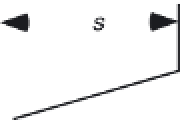Biomedical Engineering Reference
In-Depth Information
∆
∆
τ
τ
τ
τ
τ
τ
τ
τ
τ
τ
(a)
(b)
∆
τ
τ
τ
τ
τ
τ
Σ
τ
τ
(c)
FIGURE 1.17
Hassenstein-Reichardt model of motion processing: (a) preferred direction, (b) null direction, and (c) motion
director. Adapted from Refs.
55-57
.
the view as seen by photoreceptor A is time
delayed by
τ
and then multiplied by the immedi-
ate response from photoreceptor B. If the two
photoreceptors have seen the same stimulus,
there will be a high correlation, as indicated by
a large response from the multiplier. The left-to-
right motion is said to be in the
preferred direction
for this arrangement see
Figure 1.17
a. On the
other hand, a stimulus traveling from right to
left (termed the
null direction
) will have a mini-
mal response from the multiplier stage; see
Figure 1.17
b.
To detect motion in both directions for a given
pair of photoreceptors, a mirror-image configu-
ration of hardware is added; see
Figure 1.17
c.
This results in a large positive response in the








































































































































































